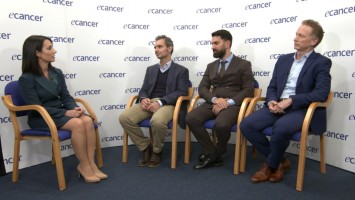Enfortumab vedotin in combination with pembrolizumab is a potential new standard of care for 1L la/mUC
Dr Michiel Simon Van Der Heijden - Netherlands Cancer Institute, Amsterdam, Netherlands
For advanced urothelial cancer, the mainstay of systemic treatment has been platinum-based chemotherapy for decades. Although a few advancements have been made, the median overall survival still remains low and most patients die of their disease within two years.
In the EV-302 study we compared enfortumab vedotin, or EV, with pembrolizumab and compared this against platinum-based chemotherapy. So per protocol patients had to follow the platinum agent as determined by Galsky criteria – cisplatin or carboplatin. Patients on the standard of care arm were also allowed to have maintenance checkpoint inhibition.
The study had as the primary endpoints progression free survival and overall survival. At ESMO last year we presented the primary analysis which showed that EV-302 met both of its endpoints of progression free survival and overall survival with highly significant hazard ratios under 0.5. At that presentation we already did limited subgroup analysis for the overall survival outcome and at this presentation we looked at all the clinically relevant and prespecified subgroups.
What we found was that EVP or enfortumab vedotin/pembrolizumab improves both progression free survival and overall survival over a range of clinically relevant subgroups. So these included the most important one, probably, cisplatin eligibility, so in both cisplatin eligible and ineligible patients EVP did better with a hazard ratio under 0.5 for progression free survival.
Liver metastases are associated with poor prognosis and also here we found that EVP did better than chemotherapy. At the other end of the spectrum is lymph node only disease which has a more favourable prognosis and, again, we found that EVP did better than chemotherapy. For this particular subgroup it was very striking that in the progression free survival the median was not even reached yet in our study. For overall survival the tail of the Kaplan-Meier curve at this analysis settled at 70% overall survival. So that’s unprecedented in this disease.
Overall what we found is that enfortumab vedotin with pembrolizumab improved progression free survival and overall survival over a range of clinical subgroups. We also looked at objective response rate and found that in each and every subgroup that we looked at at least 60% of the patients responded, including in patients with liver metastases. So that means that, in my view, enfortumab vedotin with pembrolizumab should be the next standard of care.
Also I think important, we’ve been keeping ourselves busy with cisplatin ineligibility and eligibility for decades and with these results this might be a thing of the past.
What is next for this study?
The study actually had a median survival follow-up of 17.2 months. With this survival follow-up we also already saw a very clear difference and the study is certainly mature enough to really establish that this is a superior treatment. But we are, of course, still very interested in seeing what the long-term survival of these patients is. So, like I said before, in the lymph node only disease, for example, we see already a tail of the curve forming at around 70%. It will be very interesting to see if that tail will hold up. It will be for the group as a whole, of course, be very interesting to see if there are patients who truly have long-term durable remission as we have seen in the previous single arm studies with this combination.








